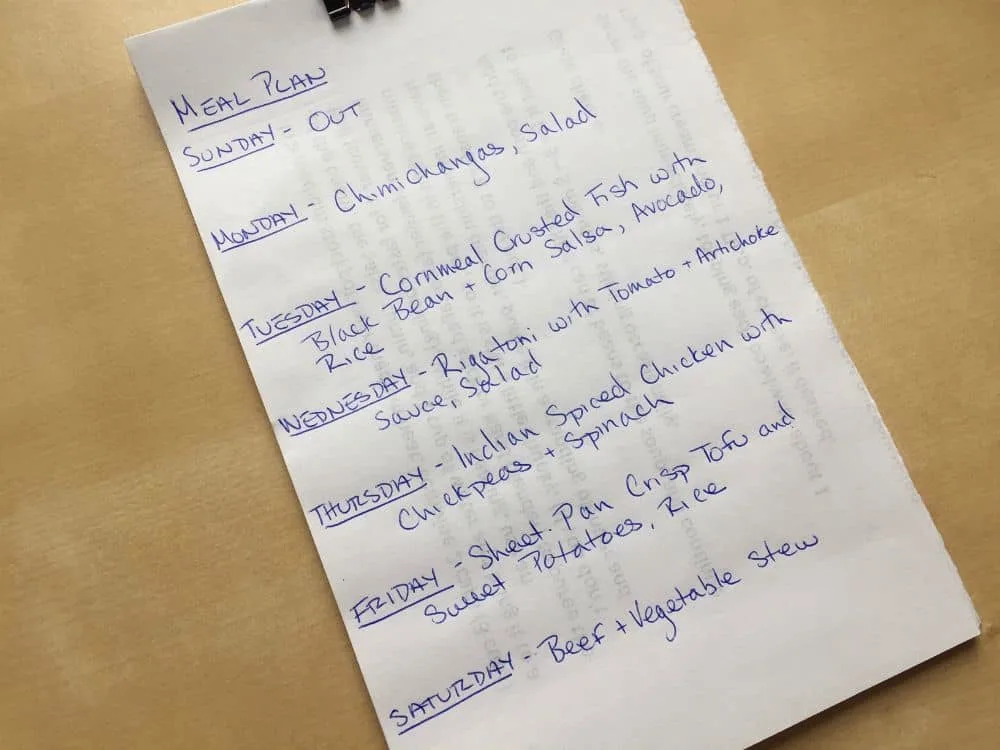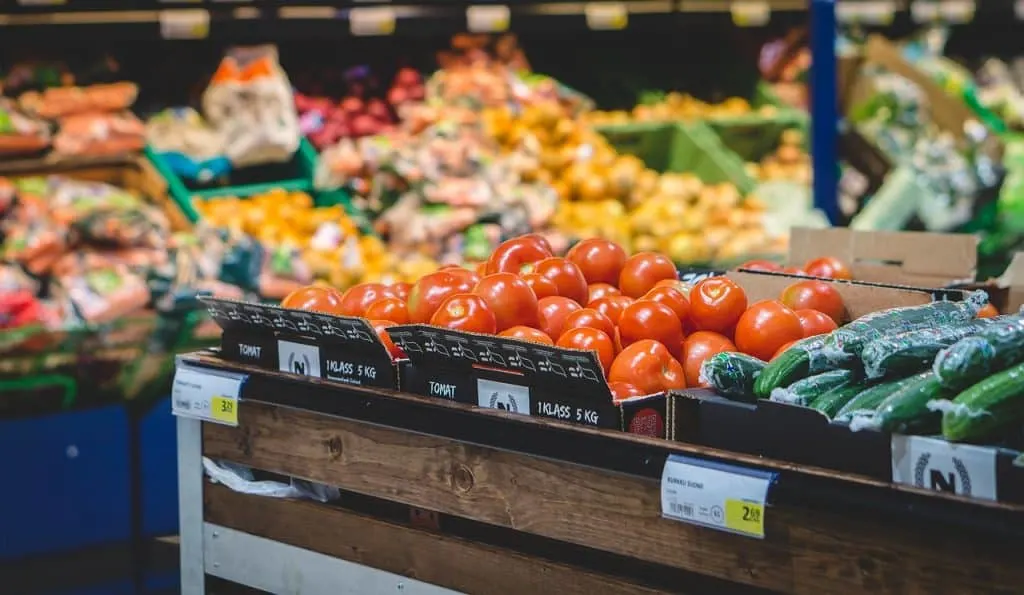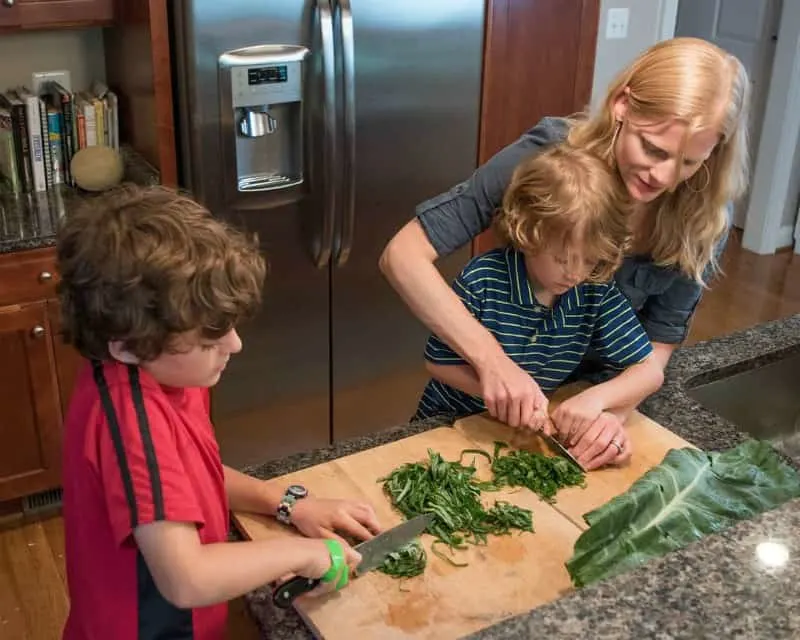Are you frustrated with the way meals are going in your house? Depending too much on takeout or cereal for dinner? Tired of the late-afternoon panic to figure out what’s for dinner? Then maybe it’s time to turn things around with my 10 ways to make meal planning easy.
Confession time: For years I resisted meal planning. I saw it as an extra task to add to my list, I chafed at the idea that I would be stuck eating a meal I no longer felt excited about, and I figured I was a good enough cook that I could just make meals up on the fly. But once my kids were in preschool and our schedules became busier and busier, I found myself stressed and scrambling almost every night and decided something had to change.
It took me a couple of months of trial and error, but once I landed on a meal planning process that worked for me I saw a ton of benefits including:
- saving money, both on extra trips to the grocery store and unnecessary take-out
- saving time
- sticking with healthier choices (I found it easier to stick to my goals if I had a plan)
- less panic and stress as dinnertime approached
As I know from my own experience, getting over the hump and actually sticking with meal planning is a big struggle for a lot of people, so I wanted to share my list of 10 ways to make meal planning easy.

10 Ways to Make Meal Planning Easy
1. Keep It Simple
There are all sorts of meal planning approaches out there – the classic weekly plan, two-week rotations, thematic approaches, and monthly systems. In my experience, when you are just getting started the longer-term plans can be daunting. So, I recommend starting with a simple system such as a weekly plan or even just picking a few recipes to use during the week. You can always opt for more complicated later, but starting simple and small increases your chances of success.
Bonus tip: If coming up with new ideas each week feels overwhelming, there are two different ways you can make it easier:
- Try a thematic approach where each day of the week has an assigned meal type either by protein (Meatless Mondays, Chicken Tuesdays, etc.) or by ethnicity (Taco Tuesdays, Pasta Wednesdays, etc.). This will help to streamline your decision making process.
- Create a two or three-week rotation. To use this approach, make a list of all of the recipes that work well for your family, including super simple meals like sandwiches and breakfast for dinner. The goal is to get between 10 and 15 meals. Using this list, you can then plan out a few weeks’ worth of meals, which you can rotate through over an over again. Then, if you start to get sick of one of the meals, you can just swap that meal out for a new recipe and keep the rest of the plan the same.
2. Check with Yourself
Each week, before you jump into planning, do a little check-in with yourself. Ask:
- What do I feel like eating?
- How do I feel about leftovers?
- How much time am I willing/able to spend on cooking this week?
- What does my schedule look like this week?
- Which days will I have time to cook and which days will there be a crunch?
- Are there foods in the fridge or pantry that need to get used up?
Use the answers to these questions to inform your meal choices and I bet you’ll find that you are happier sticking to your plan than you expected.

3. Check with Your Family
When I sit down to meal plan each week I always ask my family if there is anything that they would like on the plan for the week. This serves two purposes: 1) I don’t have think up as many ideas and 2) I get more buy-in at every meal if they know that their favorites have been included in the week’s plans.
Some families also use this time to get each family member to take responsibility for cooking one meal for the week, especially as kids get older.
4. Make Your Plan
Search for the recipes that you plan to make in cookbooks, online, or with a meal planning service like The Scramble. Think about if there are ways to save time and effort by making extras to be eaten as leftovers, used in another dish (e.g., leftover rice can become fried rice, leftover protein can become fillings for paninis or mixed into pasta sauce, and leftover vegetables can be added to sauces, salads, chimichangas, or sandwiches), or frozen for another week.
Want more ideas for using up leftovers? Check out my post on repurposing leftovers.

5. Make Your Shopping List and Organize it by Grocery Store Section
Having a grocery list ready to go will always make grocery shopping faster and cheaper (fewer impulse purchases).
To make your list, first take an inventory of your pantry to see what you already have. Add the items you need for the recipes you’ve got planned. And finally, add on your weekly staples such as bread, milk, lunch supplies, etc.
While it may seem like it’s taking things a step too far, using a few minutes to organize your shopping list by grocery story section will make your trips much faster and reduce the chances of forgetting an item.
Bonus tip: The Scramble’s meal plans include a shopping list that is already organized by grocery story section for you, so all you’ll have to do is add on your weekly staples!
6. Pre-Prep
When you get home from the grocery store, consider taking 30 minutes to an hour to pre-prep food to make cooking easier during the week. Pre-prep can include chopping vegetables, grating cheese, or mixing up marinades. This is a great activity to get the whole family to help with!
Did you know that The Scramble’s recipes and meal plans help you with the pre-prep step? Each recipe comes with Do Ahead and Delegate options, so you know what can be done ahead of time.

7. Post the Plan
Post your plan for the week somewhere where everyone can see it. This will decrease the “what’s for dinner?” questioning and will help to remind you of what you might need to take out of the freezer to defrost, put into the slow cooker in the morning, etc.
8. Don’t Want What You’ve Got Planned? Tweak it!
This will happen. It happens to all of us. So here are three ways to handle those moments:
- Tough it out and make what you planned, but try to change your mood with some fun music, a glass of wine, or a kitchen dance party
- Adjust days in the meal plan so you get something you’re more excited about (this is what I usually do)
- Tweak the recipe with different spices, different protein, different grain, something that will make it more appealing to you

9. Leave One Night Unplanned
While some people prefer to plan out all seven meals for a week (and some prefer to plan all 21+ meals), I like to plan out six dinners and have a general plan for breakfasts, lunches, and snacks. This is because invariably our weeks don’t go as planned – something goes awry, you receive an unexpected invitation, or you have leftovers to finish up – and so I like to have some flexibility.
Bonus Tip: One of my favorite options is to use the bits and pieces we have leftover at the end of the week to have a “pick up” night. This is where all the options get put out on the kitchen counter and everyone gets to “pick up” what they want to eat.
10. Get Help
Meal planning is an incredibly helpful and important habit to get into, but if these steps feel like too much to take on, check out The Scramble’s family-friendly meal plans!
I’d love to hear from you! Do you have any meal planning tricks that help you to get dinner on the table? Share your thoughts in the comments!

Keeping Busy Families Organized with Cost-Efficient Strategies - FROG Reviews and RamblingsFROG Reviews and Ramblings
Wednesday 29th of November 2023
[…] you’re looking to save time and money when it comes to your daily meals, creating a meal plan can be an incredibly effective strategy. By taking the time to plan out your meals, you can avoid last-minute trips to the grocery store or […]
Why Grocery Lists Matter and How to Make Them Work for You
Thursday 12th of January 2023
[…] I made a change: I began planning our meals and writing out a grocery list more carefully. The shift that occurred was amazing – I saved […]
Thara
Tuesday 20th of December 2022
Flexibility is the ultimate key. I do a five day meal plan at the moment. I take inspiration from a variety of sources like cookbooks and culinary sites. I take a good and careful look at my cupboards in order to see what items I have to use. I build up a meal plan that is based on ingredients I have at home.
Tips on How to Get Your Kids to Cook Dinner
Wednesday 9th of November 2022
[…] cooking a meal they wanted to eat, and 2) I wanted them to also start to learn the life skill of meal planning and generating a grocery list. […]
Thara
Thursday 11th of August 2022
Heya.
Be clever and very creative here as much as possible. Shop around carefully in order to find more useful products and look at some free recipes online too. Make some brief summary notes as well. Also buy items like cheese, fruit, veg and cuts of meat on the cheap at garden centre farm shops and the stalls located at weekly local farm markets in addition.
You can even certainly still happen to find a lot of good current deals at big supermarkets on certain products like discounted bottles of wine and beer that is definitely worth knowing about additionally. Pick your own farms often have many surplus fresh produce to sell to customers or try your luck at the big popular classic country shows etc. Good luck. Search online to learn more.
Think outside of the box. Farm shops stock things like chutney. You can aim to find a lot of nice stuff that way. Find up to date relevant information online additionally to use. If you attend social events inquire carefully if you can have any free leftover cakes and so on to take back home to eat on your own later.
Adapt recipes to your tastes. Have picnics.
Jessica Braider
Thursday 11th of August 2022
These are all awesome suggestions! Thanks for sharing them!